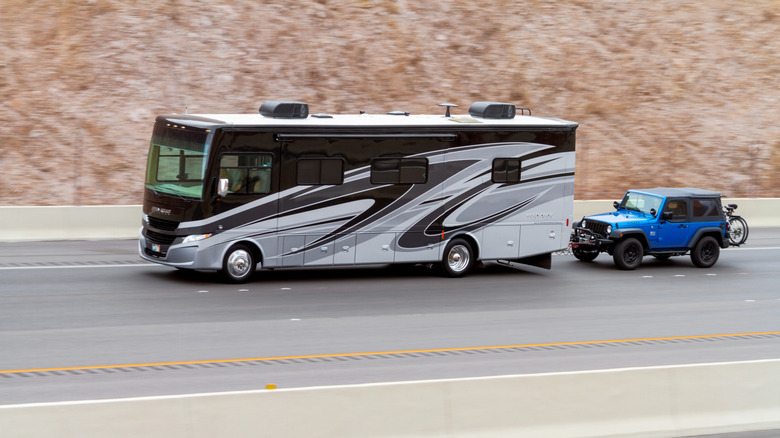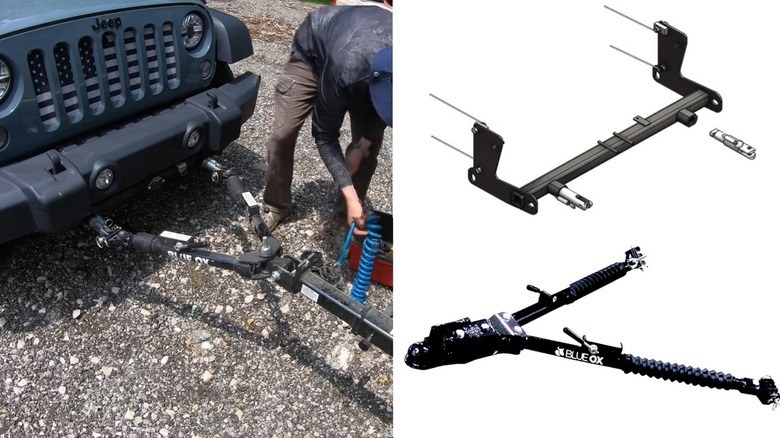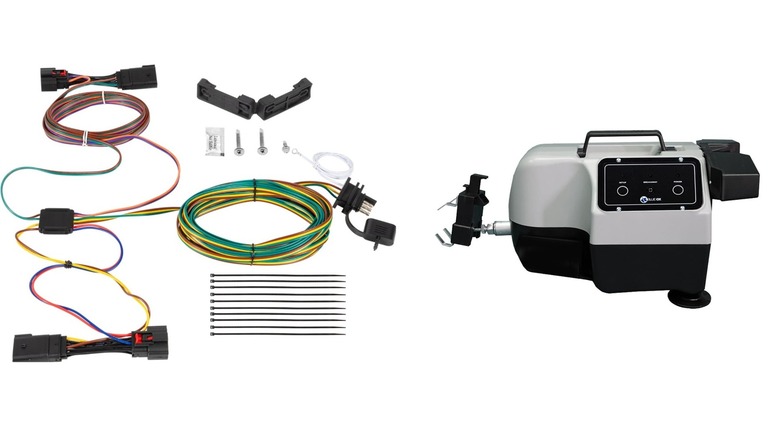What To Know (And What You Need) Before Flat Towing Your Jeep
We may receive a commission on purchases made from links.
Flat towing — or dinghy towing — where all four wheels stay on the ground, is common among motor home owners who want a smaller vehicle known as a "toad" to run errands or take side trips while camping. Not only can you flat tow many Jeeps, but you can also tow with them — here's every Jeep model you can buy in the US ranked by towing capacity.
While every Jeep Wrangler and Gladiator as well as Cherokees and Grand Cherokees with Active Drive II or Quadra-Trac II systems can be safely flat towed, you should never do so with a Jeep Renegade or Compass. Essentially, if there isn't a way to disengage the drivetrain and allow the wheels to turn freely, you will cause substantial damage to the vehicle while flat towing.
The safest way to free up your wheels is by disconnecting the driveshafts and securing them to the frame with baling wire or heavy-duty zip ties. If you prefer not to do this, shift the transfer case to neutral and put the transmission in park for an automatic and in gear for a stick shift before attempting to tow. My family purchased a Jeep Wrangler Sport specifically to tow behind our class A motorhome and it required several extras to make it safe and legal. These included a base plate, tow bar, lighting kit, and brake system.
Connecting the Jeep to the tow vehicle
One of the first steps toward flat towing a Jeep is installing a base plate, which is a high-strength steel bracket that is bolted to the frame. In my case, I opted for the Blue Ox Custom tow bar base plate which fits JL series Wranglers. There are cheaper options out there, but I chose the Blue Ox product because it had the most reviews and an average star rating of 4.6 out of 5.
Once you receive the base plate, you can either have it installed by a local shop or do it yourself. My wife and I installed it after being quoted around $900 for a professional installation, and we found this U-Haul base plate installation guide video to be very helpful.
Next, you'll need a tow bar, which is a hinged brace shaped like the letter "Y." The single end has a standard trailer hitch receiver, and the two arms connect to the base plate on your Jeep with steel pins. I opted to go with the Blue Ox BX4330 class III tow bar for its high ratings and ease of use. Like with base plates, there are less expensive options, but the adjustable arms on the Blue Ox made lining the Jeep up behind the motorhome a more forgiving process. Sometimes the right accessories make all the difference.
Lights and a flat tow brake are critical
Lights are important whenever towing, both in terms of legality and safety. I purchased the BX88368 Blue Ox EZ Light wiring harness kit because it's compatible with many vehicles and integrates with existing lighting systems. My wife and I secured the wires from the taillights to the base plate with zip ties by crawling underneath the Wrangler, avoiding areas that get hot. This harness ends in a connector at the base plate ready to accept a four-pin connection to the tow vehicle. One of the benefits of spending so much time working on the Wrangler was finding the hidden easter egg on our Jeep.
Another product legally required in most of the US for flat towing is a trailer brake, with a varying weight threshold depending on the state. We went with the Blue Ox BRK2022 flat tow brake as it was the only name-brand product available on Amazon. This device clamps onto your Jeep's brake pedal, detects when the towing vehicle is slowing, and braces against front seat to apply adjustable pressure on the Jeep's brake pedal. It plugs into the 12-volt accessory socket, and includes a remote stop controller and emergency connection to the towing vehicle. This ensures that if the two vehicles somehow get disconnected, the brake will automatically slow the Jeep to a stop.


